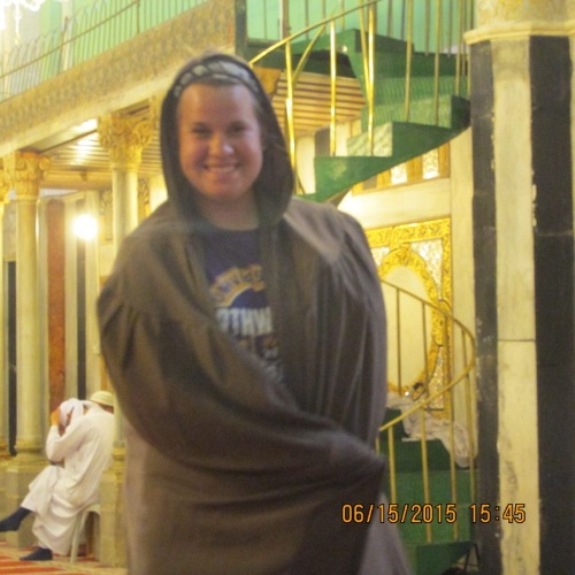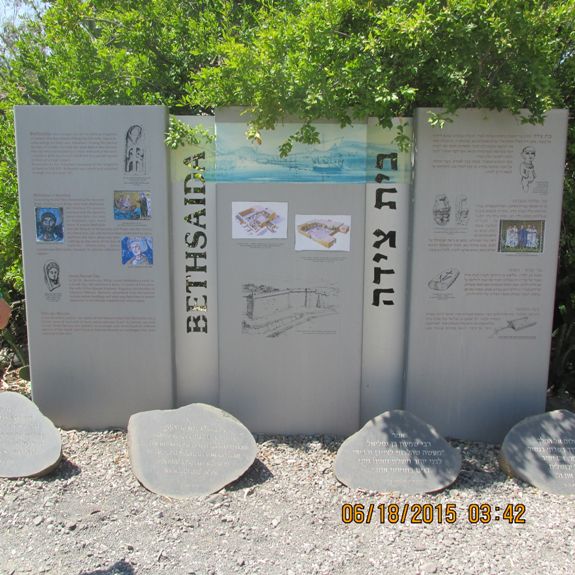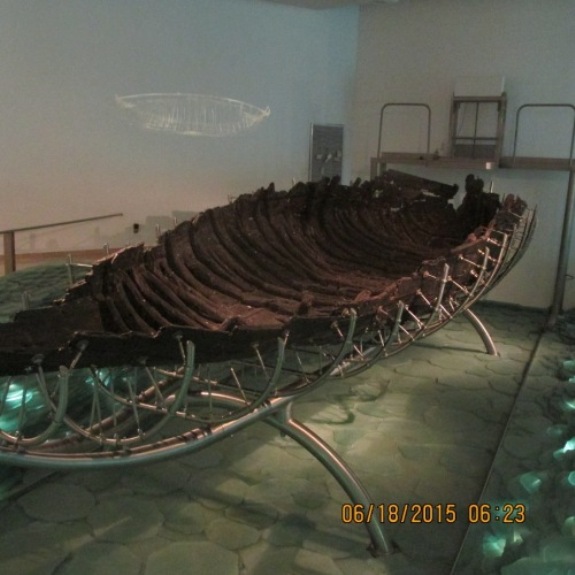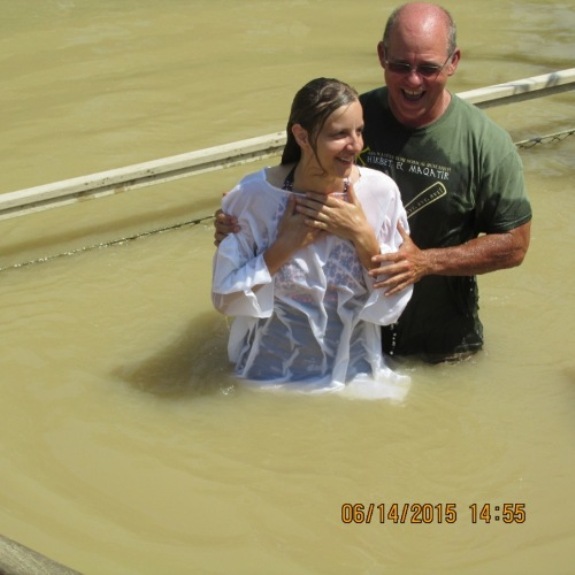Touring the Land of Milk and Honey
With the 2015 summer dig season complete, 22 volunteers took a day of rest (Shabbat) before embarking on a series of field trips in the Holy Land. While many of the sites visited are well-known, just as many are not well known to many of the group. But where to start?
Southern Jordan (Sunday): Our first day trip was south along the Jordan River to the famous palace fortress of Masada. In many ways, it represents man's yearning to remain free from oppression, even to the point of dying rather than be oppressed. Masada is where a band of Israelite rebels fled during the Jewish rebellion around AD 70 becoming the last holdout. In was during the final days of the siege that the band of rebels determined that becoming slaves to the Romans was unacceptable. Thus, these men and women determined to sacrifice themselves through mass suicide, leaving a silent fortress for the Romans to conquer.

The Group at Masada
Leaving Masada, we had hoped to float in the Dead Sea, but unfortunately, a sinkhole prevented access to the resort where that would be possible. However, that did not discourage the group, as we continued to Qumran, the site of the most significant archeological discovery associated with Scripture, the Dead Sea Scrolls. Visiting the site where a group of Essenes sought to find a connection with God, while making a statement about the evils of the Jewish practices in the Jerusalem Temple, provided each of us with renewed strength to be willing to stand up for our beliefs as well. Since Jesus does not negatively mention this group, it may be that he had some relationship. The general consensus is that he knew of them and viewed them somewhat favorably since only the Pharisee and Sadducee groups are mentioned in Scripture and not very favorably. We also visited the Jordan River location where many groups, including ours, now think that John the Baptist would have baptized Jesus. This lovely location prompted each of us to reflect on our relationship with God and was a welcome respite from the heat of the desert road as we continued northward back to Jerusalem.

Mikveh bath (ritual cleansing) steps
Our final stop was at the Inn of the Good Samaritan Museum where the Israeli Antiquities Authority (IAA) has gathered and displayed items that were in danger of being destroyed. This collection of artifacts provides a quick overview of many of the cultural and historical periods that can be seen in Israel. Mosaics and architectural features alike helped each of us on the tour to get a better understanding of the history of the land of milk and honey.
Herodium, Bethlehem, and the burial cave of Abraham (Monday): This day started with a trek up the Herodium, a fortress-palace built by Herod the Great. Herodium may be the location from which Herod sent his soldiers to Bethlehem to kill all the boy babies in an attempt to destroy the child that the Magi called the King of Israel. This magnificent building, Herod's burial location on the side of the hill and the lower palace all attested to the architectural capabilities of Herod and his architects. He was a visionary, but his vision was clouded by his selfish desire to be the King of Israel. He strove to ensure his legacy through buildings, temples, and palaces, but in many ways his legacy is one of cruelty and death. It was easy to visualize Herod looking towards Bethlehem and sending forth his soldiers toward the Church of the Nativity.

Herodium Model
It is at this church that tradition states that Jesus was born of Mary. One can enter a space under the main altar and look into a small cave under the church where the birth is alleged to have taken place. Whether this is, in fact, the location is not that important. Hopefully, this location caused each of us to realize that God was willing to send His only Son to become a man, to live as a man and even to die in order that we may regain the eternal fellowship with God that was lost through sin.
From there, we continued our tour by moving to Hebron, where we were able to view a synagogue and mosque positioned over a burial cave. According to Scripture, Abraham purchased from Hethites a cave named Machpelah. Of course, our ladies, in order to enter the mosque, had to clothe themselves appropriately with the cloaks provided by the mosque personnel, and we all had to remove our shoes. Afterward, we sought out the location of Tel Hebron to see the ruins from the time of David and earlier. It was here in Hebron that David first ruled as King of Judah and then moved to Jerusalem once he became King of all of Israel.

Rachel in her gown
Jericho and north to Beth Sean (Tuesday): This day started with our tour guide (Scott Stripling) turning the reins over to Bryant Wood. Bryant provided a wonderful overview of the ancient city of Jericho, especially as it pertains to the biblical account of Joshua and his conquest of the city through God's miracle of causing the tremendous walls of Jericho to come tumbling down. Through the archeological evidence, it is possible to see how the Israelites were able to walk straight up into the city without having to climb a wall. The evidence seems to be clear that what happened according to the Scriptures is what actually happened. Again, it was not the actions of men that accomplished the conquest, but the actions of God with men doing as He directed that obtained the "First Fruits" of the conquered land.
From Jericho, the group went to the city of Archelaus. This city named after one of the sons of Herod the Great is another example of the efforts of men to produce a lasting legacy. Archelaus assumed control of the surrounding area upon the death of his father, but because of his intolerable misrule he was replaced in 6 AD. Unfortunately, this area is being assaulted by antiquities robbers who leave huge holes in the ground; the partial artifacts left behind are just begging for someone to retrieve them. The looters only want complete artifacts to sell on the antiquities market. It is very sad to see the destruction of a rich archeological site.
The group then proceeded to OT Beth Shean, also known in NT times as Scythopolis. It was one of the cities of the Decapolis mentioned in the NT. This beautiful city is full of Greek and Roman influences. It was in the Decapolis that the demonaic presented the Gospel after Jesus freed him from a legion of demons.
Caesarea Maritima and Gezer (Wednesday): Herod the Great built Caesarea Maritima as a tribute to his sponsor Caesar Augustus. Herod built a man-made harbor on the coast of Israel to bring in commerce. The seat of the Roman procurators of the province of Judea, and the headquarters of the Roman legions stationed in the province was in Caesarea. It was from this city that Pontius Pilate left to be in Jerusalem during the Passover when Jesus was captured and brought before him for punishment. It was Pilate that asked Jesus, "What is truth?" Leaving Caesarea Maritima, the tour group went to Gezer to see the archeological excavations there under the direction of Steve Ortiz. Steve provided a great overview of the excavations and how the city is associated with the building projects of Solomon. Both Scripture and the archeological understanding of the six-chambered gate complex support the Solomonic dating. Scripture (1 Kings 9:15) states that Solomon fortified Hazor, Megiddo, and Gezer. The archaeology at these three sites shows similar construction techniques, especially the gate construction.
Galilee and the Lake (Thursday): Thursday morning found the group heading north to the Sea of Galilee; specifically Bethsaida, Capernaum, the "Jesus Boat", Magdala, and the ruins at Hippos (another of the Decapolis cities). Note that the vast majority of Jesus' miracles occurred among the people residing in the northern portion of Galilee. Our first site visit was at Bethsaida where at least four the disciples came when called by Jesus. We also observed the excavation of an Iron Age II (1000–586 BC) settlement. During this Iron II time, Bethsaida was part of the land of Geshur ruled by King Talmai (2 Sam. 3:2–3), whose daughter, King David of Israel married. One offspring of this union was Absalom, who later sought refuge in Geshur after slaying his half-brother Amnon (2 Sam. 13:37). After a site tour by Dig Dirctor Rami Arav, we continued around the lake to Capernaum, Jesus' ministry headquarters. In Capernaum, the magnificence of a 4th-century synagogue atop the foundation of a first-century synagogue was viewed, as well as the remains of a first-century village. Over the ruins of one of the houses, an octagon shaped church was built to commemorate the church house associated with Peter.

Welcome to Bethsaida
Then, it was on to see the "Jesus Boat" rescued from the mud of the Sea of Galilee. While called the "Jesus Boat" it is impossible to associate it positively with Jesus, but it is representative of the boats available to the disciples and Jesus. The conservation effort performed to preserve this boat was accomplished by Orna Cohen, who is working with us to conserve the various artifacts we unearth at Khirbet el-Maqatir. Much has been learned by studying the boat and the group came away with a better understanding of the many stories in the Scriptures associated with the Lake and Jesus using the disciples' boats. After a lunch break, we moved to the town of Magdala where we viewed an early first-century synagogue and learned a bit about the town that Mary of Magdala lived in when Jesus healed her. The archaeology of this location is being preserved and will become part of a "pilgrim" hostel and Pilgrim Spirituality Center in the North. Once completed, this will provide a place for meditation and reflection of the healing capabilities of Christ.

The "Jesus Boat"
The Dead Sea Float Experience and City of David Tour (Friday): On the last day the group was able to go to a different location on the Dead Sea to float in the mineral-rich waters. So, off to the Dead Sea the group went. After floating for some time, they determined to head back to the hotel for lunch and then tour the City of David. En route to the City of David on foot, Scott explained many of the obscure, but important features in the Old City.
Post Log: During the tour, a great many beautiful sites, ruins, and locations were viewed. Over and again, one visual experience after another seemed to exceed the previous experiences. In reality, however, there is only one experience not exceeded by any of the physical sights. On day one, I mentioned that we visited the place when John the Baptist baptized Jesus. It was here that the supreme experience occurred! Sherry Klick, one of our group, had asked Scott Stripling if he would baptize her in the Jordan River. While being baptized in the Jordan River is somewhat neat, the real excitement was to see the joy of Sherry upon emerging from the covering waters that welcomed her into a renewed relationship with Jesus. It was Sherry's radiant joy that eclipsed every other sight seen during the week of touring the Land of Milk and Honey. I can only imagine the excitement and joy in heaven as Sherry proclaimed her love for Jesus. That experience truly was the most beautiful one of the entire tour!!

Sherry's Baptism
Note from Dig Director Scott Stripling - The post dig tour was a huge success. Much of the staff was working all day, every day back at headquarters to wrap up the myriad of administrative tasks. Without the contribution of each team member, none of our important work would be possible. In the days ahead, I will be making a major announcement from this summer's dig. Everyone is leaving, tomorrow, but I will remain behind for a few more days of meetings and final administrative details. Your prayers and financial support are greatly appreciated.
Please take a moment right now to send a donation to help underwrite the dig expenses. No gift is too large or too small. Together we make it happen!
Donate to the Khirbet el-Maqatir Excavation and Research! (Please note in the SPECIAL INSTRUCTIONS section that you gift is for the Khirbet el-Maqatir Excavations).